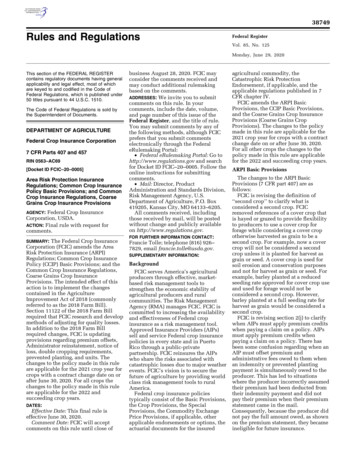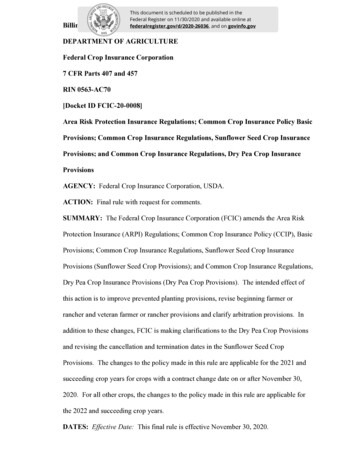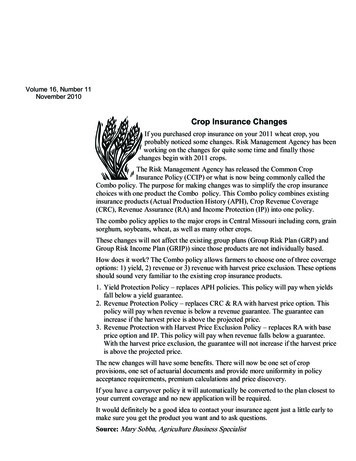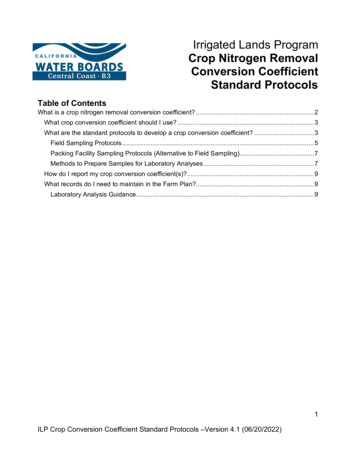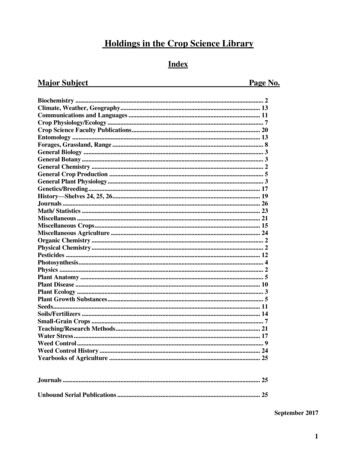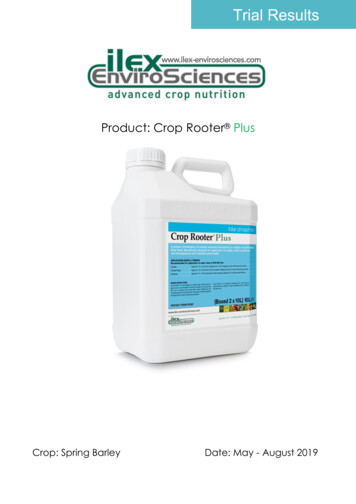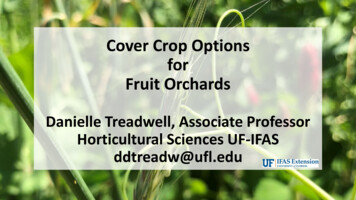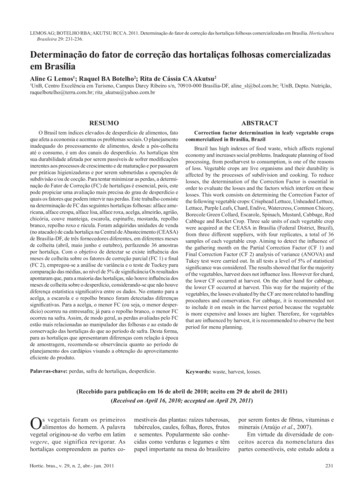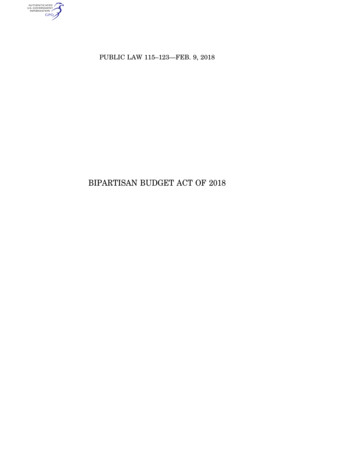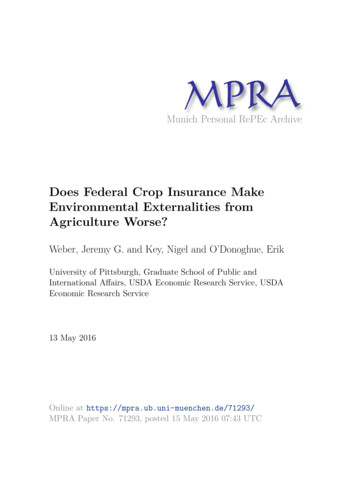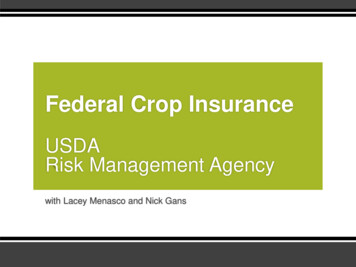
Transcription
Federal Crop InsuranceUSDARisk Management Agencywith Lacey Menasco and Nick Gans
DisclaimerThe purpose of the following material is to promoteawareness of risk management concepts and to highlightUSDA’s risk management products, features, benefits andavailability.This material does not change the content or the meaningof current policy provisions, filed actuarial documents orapproved procedures.
Overview USDA Risk Management Agency– Our purpose and intent Grape Insurance Policy Overview Whole Farm Revenue Protection Overview
What is RMA The United States Department of Agriculture’s (USDA) RiskManagement Agency (RMA) was created in 1996 Serve America’s agricultural producers by strengtheningeconomic stability Responsible for increasing effectiveness and awareness
What is RMA Continued Maintain public-private partnership with Approved InsuranceProviders (AIP)– Responsible for selling and servicing insurance policies RMA backs the AIPs who share the risks Faster way to support agriculture after catastrophic weathereven
The Farm Safety Net Farmers and ranchers need to regularly manage for adverseweather and financial, marketing, production, human -resource,and legal risks. The pre-eminent risk management solution for farmers andranchers. Some common risks covered include drought, frost, anddisease The difference between staying or going out of business after adisaster
Where to Buy Crop InsuranceAll crop insurance policiesare available from privatecrop insurance agents.A list of crop insuranceagents is available at anyUSDA service center or onthe RMA website atwww.rma.usda.gov/tools/agent.html
Multi-Peril Crop InsuranceFor Grapes
Grapes are insurable if: You have a share in the crop; They are grown for wine, juice, raisins, or canning; The actuarial table provides a premium rate They are grown in a vineyard that, if inspected, is consideredacceptable by the insurance provider; They have reached at least fourth leaf; (third leaf after grafting);and They have produced an average of two (2) tons of grapes peracre during at least 1 of the 3 crop years immediately precedingthe current crop year (unless we inspect and allow insurance onsuch acreage) or as specified in the special provisions. The actuarial table provides a premium rate
Grapes are Insurable in:Idaho - Ada, Canyon, Elmore, Owyhee, Payette, and Washingtoncounties.Oregon - Benton, Clackamas, Douglas, Hood River, Jackson,Josephine, Lane, Linn, Marion, Morrow, Polk, Umatilla, Wasco,Washington, and Yamhill counties.Washington - Benton, Chelan, Clark, Douglas, Franklin, Grant,Island, Kitsap, Kittitas, Klickitat, Mason, Okanogan, Pierce, SanJuan, Skagit, Skamania, Walla Walla, and Yakima counties.*Coverage may be available by written agreement in other counties.Submit requests to your crop insurance agent. Rates and transitional yields are established by county
Causes of Loss You are protected against the following:– Adverse weather conditions;– Earthquake;– Failure of irrigation water supply, if caused by an insured peril thatoccurs during the insurance period;– Fire, unless weeds and other forms of undergrowth have not beencontrolled or pruning debris has not been removed from the vineyard;– Insects, except Phylloxera, regardless of cause, and not damage dueto insufficient or improper application of control measures;– Plant disease, but not damage due to insufficient or improperapplication of control measures;– Volcanic eruption; or– Wildlife.
Important Dates Sales Closing:November 20, 2017 Production Reporting Date:January 15, 2018 Acreage Report Date:January 15, 2018Insurance PeriodFor each crop year that the policy remains continuously in force,coverage begins on the day immediately following the end of theinsurance period for the crop year before.
Reporting RequirementsAcreage Report - You must report to your crop insurance agentall the acreage (insurable and non-insurable) of grapes in thecounty in which you have a share (your share at the timeinsurance begins), reporting the crop by type.Production GuaranteesYields are based on actual production records reported to yourcrop insurance agent and/or insurance company.
Coverage Levels One price election and one coverage level for each grape type– If you choose Catastrophic Risk Protection (CAT) for any varietal group,all other grapes have that price and coverage level You can choose a coverage level of 50 (CAT) to 85 percent ofyour approved average yield (in 5-percent increments). CAT coverage is available at the 50-percent coverage level and55 percent of maximum price election.
Price Election Price elections are the price of compensation paid, per ton, in the eventof a loss.– Please contact a crop insurance agent for prices. Price elections for each type are not required to have the samepercentage relationship to the maximum price we offer for each type– Insure 100% of Pinot Noir, but then 80% of Chardonnay
Price Election Continued Your price contained in grape contract can be used This contract price is without incentives or discounts If more than one contract price exists, will use weightedaverage of all contract prices for varietal Maximum contract price exists– The price is always less than the maximum contract price provided in theactuarial documents for the applicable grape type/variety.– For example, in Yamhill County, Pinot Noir has established price of 2,480per ton, with a maximum of 3,720
Price Election ContinuedGrapes may be insured using the contract price only if: A written contract is in effect between you and a winery or aprocessor for the current crop year; The contract states the amount that will be paid per ton andnumber of tons or acres contracted; You provide a copy of the contract(s) before the acreagereporting date;– Jan 15 All production from insurable acreage of the variety is grownunder a grape contract; and Your acreage is insured at a buy-up coverage level.– Not catastrophic (50% coverage level)
Loss Example 20 acres of wine grapes 100-percent share 70-percent coverage level 100-percent price election ofPinot Noir in Yamhill County at 2,480/ton Average yield of 3 tons (actualproduction history)
Loss Example Continued3x.702.1xTons per acre averageCoverage levelTons per acre guarantee20Actual Acres42Tons unit guarantee(price of 2,480/ton)-20Tons of actual harvested production (1 ton/acre)22Ton lossx 2,480 54,560Price electionIndemnity due policyholder (less insurance premium due)
Cost Estimator 20 Acres, Irrigated Pinot Noir Yamhill County, OR 100% Price Election 2,480 Average yield 2 tons/acre 70% Coverage Level Liability: 104,160 Total Premium: 4,213– Producer Premium: 1,727– Subsidy Amount: 2,486
RMA.USDA.GOV
Insurance Participation in Oregon Approximately 25% of the grape acreage in Oregon is insured– Around 70% in Washington and 80% in California Of the 102 policies sold, 47% are CAT, and 53% are Buy-up
Items to Remember Contact a Crop Insurance Agent. If concerned about meeting 2 ton requirement for once everythree years and prices, look into WFRP Go to rma.usda.gov for Cost Estimator and Agent Locator– Under quick links
Whole Farm RevenueProtection (WFRP)
What does WFRP Cover? Revenue from all commodities produced on the farm:– Up to 8.5 million of revenue– Including animals and animal products ( 1 million max)– Commodities purchased for resale (up to 50% of total)– Excluding timber, forest, forest products, and animals for sport, showor pets
What are the features of WFRP? Coverage levels 50-85%– 5% increments– Diversification of 3 commodities (commodity count) required for 80%and 85%– No catastrophic level of WFRP available Historic revenue is adjusted to reflect farm expansion– Automatic indexing process accounts for farm growth historically(Insured may opt out of Indexing)– Expanding operations provision allows for up to 35% growth overhistoric average with insurance company approval Available in every county of the US
WFRP Premium Subsidy Premium subsidy is available and depends on farmdiversification– Farms with 2 or more commodities (commodity count) receivewhole-farm premium subsidy– Farms with 1 commodity receive basic premium subsidyCoverage Level505560657075BasicOne Commodity.67.64.64.59.59.552 CommodityCount.80.80.80.80.80.803 PlusCommodityCount.80.80.80.80.80.808085.71.56
What kinds of farms canbenefit from WFRP? Well-suited for:– Highly diverse farms– Farms with specialty commodities– Farms selling to direct markets, specialty markets, regional or localmarkets, and farm-identity preserved markets Available to all farms or ranches that qualify There are some limits for qualification
How is the amount of insured revenuedetermined? WFRP insured revenue is the lower of:– Your current year’s expected revenue (determined by your farm plan) atthe selected coverage level, or– Your historic revenue adjusted for growth at the selected coverage levelDoes diversification on my farm matterfor WFRP? Yes! The number of commodities produced are counted toward thediversification requirement within WFRP which determines– Diversification discount– Premium Subsidy– Allowable coverage level
What information do I have toprovide? Schedule F farm tax records (5 years plus a lag year) If you don’t file a Schedule F then your farm tax formsplus supporting information to complete a SubstituteSchedule F. Your farm plan for the upcoming year showing whatcommodities you plan to produce, how much will beproduced, and the expected values. Commodity inventory information, and accountsreceivable or payable.
What causes a loss paymentunder WFRP? Natural causes of loss and decline in market price during theinsurance period Taxes must be filed for the insurance year before any claim canbe made When revenue-to-count for the insurance year is lower thaninsured revenue, a loss payment will be made.
WRFP Loss Example 2,000,000Approved RevenueX85% Coverage level 1,700,000Insured Revenue (Guarantee)-1,000,0002017 (Revenue for insurance year) 700,000 Revenue Loss (Indemnity payment)
WFRP POLICIES – SPOKANE 1,070*Oregon*As of 12/1/16 Current available at RMA Summary of Business Tool
Top WFRP Crops in the PNWCROPWFRP ExpectedRevenueCROPWFRP ExpectedRevenueAPPLES 761,106,064GRAPES (Wine) 42,927,540POTATOES 147,570,303BARLEY 35,923,409SWEETCHERRIES 134,087,182ONIONS 34,003,182ALFALFA (IRR) 125,913,154SUGAR BEETS 29,466,432PEARS 95,187,538ONIONS (Spring) 22,686,777WHEAT (IRR) 46,840,710CORN (Silage) 21,622,471WHEAT (N IRR) 44,960,479CORN (Grain) 21,164,950
Top WFRP Crops in the PNWCROPWFRP ExpectedRevenueCROPWFRP ExpectedRevenueBLUEBERRIES 19,520,513DRY BEAN SEED 9,348,266HAY (Other) 16,281,702FESCUE SEED(Tall) 8,421,143DRY PEAS 14,316,576GRASS SEED 8,118,077TIMOTHY GRASS 12,366,409SWEET CORN(Fresh) 7,753,060COW/CALF 12,035,055KENTUCKY BLUEGRASS 7,149,537DRY BEANS 11,100,889HOPS 6,924,000PEACHES 10,214,086NECTARINES 6,864,456
Regional USDA RMA ContactUSDA/Risk Management AgencySpokane Regional Office11707 E Sprague Ave., #201Spokane Valley, WA 99206Telephone: (509) 228-6320Email: rsowa@rma.usda.govLacey Menascolacey.menasco@rma.usda.govNick Gansnick.gans@rma.usda.gov
Acreage Report - You must report to your crop insurance agent all the acreage (insurable and non-insurable) of grapes in the county in which you have a share (your share at the time insurance begins), reporting the crop by type. Production Guarantees Yields are based on actual production records reported to your
